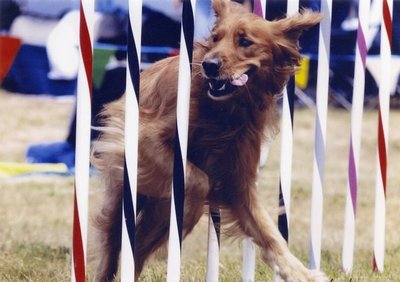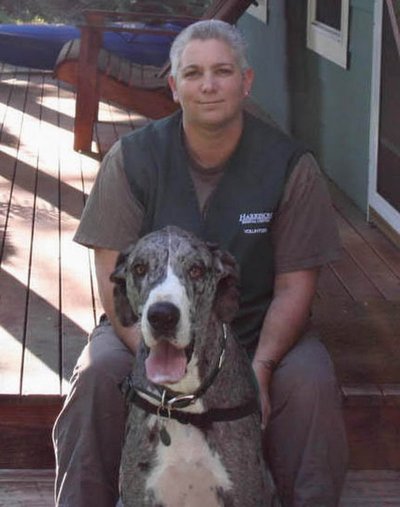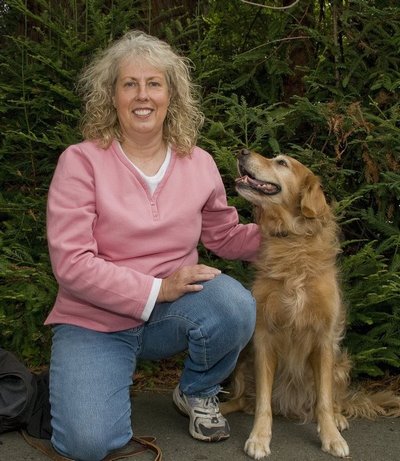October 2, 2008
A tale of two dog owners — and the canines who love them
Pam Selz and Kathy Hobson both work for the UW Medical Center’s Pathology Department and both are dog owners, but their dogs do more than provide companionship. Selz’s dog, Magnum, is a certified therapy dog, while Hobson’s dog, Jessie, is a retired dog sports champion, and she has a younger dog who is beginning to make his mark in the same arena.
Magnum is a Great Dane — a giant of a dog who stands 38 inches high at the withers (shoulders) and at 2 years old hasn’t finished growing. But while a dog that large could be intimidating, this one is trained to comfort those who need it. After getting him used to a hospital environment by visiting the UW Medical Center, Selz has begun regularly taking Magnum to visit patients at Harrison Hospital in Bremerton, near where she lives.
Magnum is one of eight dogs Selz owns, and she says his odyssey as a therapy dog began when she felt he needed to learn some social skills. “We started taking him on the ferry every day, and I noticed that he handled new situations really calmly. There were lots of kids and loud noises, and he was getting his picture taken all the time, but it didn’t seem to bother him. So I thought he might make a good therapy dog.”
She took the dog to obedience classes, and then to a special preparation class for the test administered by the Delta Society, an organization that promotes the expansion of therapeutic and service roles for animals in human health, service and education.
The Delta Society focuses not only on the dog, but on the handler, Selz says. “They want to make sure the handler is going to be able to help the dog succeed. So if you stop without telling your dog what’s about to happen, and he keeps going, that’s your fault. You have to show you can handle your dog and that your dog trusts you.”
Magnum has a special vest he wears when making therapy visits. Selz generally talks to the nursing staff first when she arrives at a hospital, to get an idea which rooms would be good for her to visit. Then she simply knocks on patients’ doors, asking if they would like a visit from a therapy dog.
“It’s so nice to see their eyes light up when they get a glimpse of Magnum,” Selz says.
The dog’s size is both an advantage and a disadvantage. He can walk right up to a patient’s bed and be within easy reach for petting. On the other hand, he’s also at the right height for food trays, which are the main things Selz has to be vigilant about. Magnum has also been known to sit on people’s laps, which in his case means backing up to the lap in question and bending his back legs. But Selz says that although Great Danes love to lean on people, Magnum is careful not to do that with children or people who are unsteady on their feet, such as those using walkers.
During a visit, Selz might have Magnum sit and shake hands, but she says that’s really the extent of his tricks. Mostly, she talks with the patient and any visitors who might be there, letting them pet the dog if they want to. “It’s really stress relief,” Selz says. “It’s just a break in their day.”
She also hands out business cards with Magnum’s picture on them, and some of his statistics — his height, date of birth, etc.
Magnum loves his work, she says. He rocks her truck in his excitement as they approach the hospital and is alert and sensitive throughout the visit. Selz loves it too. She’s currently an anatomic pathology technologist, which means she processes tissue from surgery. It’s not the most people-oriented job, so visiting the hospital with her dog is a treat.
“I love seeing people smile,” she says. “I love sharing Magnum with them.”
Hobson, who is an academic adviser in Pathology, has shared her dog with people too, but in a very different way. Jessie, a golden retriever, had been hit by a car and her hip broken in multiple places. After her recovery, she was put up for adoption as a rescue, and Hobson took her.
Given that background, Hobson couldn’t have guessed what would happen next. She took Jessie to an off-leash park, and rather than running around and playing, the dog began crawling through tunnels, walking across boards and jumping over obstacles. She was taking Jessie to obedience classes at the time, so she mentioned this odd behavior to the instructor.
“She told me I should look into agility,” Hobson says. “I didn’t know what that was.”
Agility is a sport in which dogs run through an obstacle course off leash, racing against the clock. Courses consist of jumps, tunnels, weave poles, see-saws and A-frames. Hobson had Jessie evaluated by a trainer and was told she was a natural. And when she enrolled the dog in a training course, Jessie was able to skip some levels and start out in a course for intermediates. Seven months later, she placed third in her first formal competition, and a month after that placed first.
Then, one night at class, Hobson noticed a fellow dog owner wearing a flyball jacket, and she asked about it. The other owner invited Hobson and Jessie to practice with them. Flyball is a sport in which dogs compete as relay teams. Each dog completes a series of jumps, then presses a spring loaded pad that releases a ball. The dog catches the ball in midair and carries it back to the starting line, whereupon the next dog is released.
Jessie was a natural at that sport too. “Most dogs go through two sessions of eight classes each before they’re ready to compete,” Hobson says. “Jessie was ready after five classes.”
Her first performance was a challenge, however. It was at a UW soccer game — the first time Jessie had performed outside on grass. “Then a bunch of kids came up,” Hobson recalls. “They ignored all the other dogs and started saying, ‘It’s a golden, it’s a golden.’ I thought Jessie would abandon the whole flyball thing and run after the kids.”
Fortunately, that didn’t happen, and Jessie continued participating in flyball with her cohorts. They often performed at halftime of Husky games, with a “purple team” competing against a “gold team.” The group also made several trips to New York, where they performed at halftime for Knicks’ basketball games.
Jessie retired from sports after an agility competition in which she ran off course and stopped several times — once in an official’s lap. “Even with all the delays, she still placed first, but that was it for me,” Hobson says. However, she now has two Australian shepherds, a breed known for its skill in agility competitions, and the older of the two is already competing.
And although Jessie is 10 years old now, she may have a future as a therapy dog. Hobson says they’ve taken the classes but haven’t yet earned certification. Jessie, however, has already had some experience because Hobson often took her to visit her mother in a nursing home.
“My mother always perked up when she saw Jessie,” she says, “and that’s a great feeling, to have a dog who can help someone feel better.”





